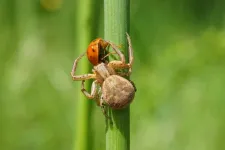(Press-News.org) Coral reefs rank among the most biodiverse habitats on Earth and are often referred to as the rainforests of the sea. Modern reef building corals evolved in the Triassic Period around 250 million years ago. They can live in symbiosis with tiny organisms, often algae, that can carry out photosynthesis. This photosymbiosis is particularly beneficial in nutrient-poor waters because it helps the corals to recycle scarce nutrients.
Geological evidence reveals that corals already existed in the Devonian period, over 385 million years ago, for example in the Eifel and Sauerland regions in Germany. Fossilized corals of the extinct orders Tabulata ("honeycomb corals") and Rugosa ("horn corals ") found in these regions indicate that the Rhenish Massif was once covered by a tropical sea during the Middle Devonian period, where huge reefs thrived. However, it is not clear whether the extinct groups of corals of the Devonian had photosymbionts or not.
A research team led by researchers from the Max Planck Institute for Chemistry, the Goethe University Frankfurt, and the Senckenberg Research Institute and Natural History Museum Frankfurt has now demonstrated, using nitrogen isotope analyses, that some extinct corals from the Middle Devonian period were already symbiotic. This represents geochemical evidence of the oldest confirmed photosymbiosis in corals.
Comparison of symbiotic and non-symbiotic corals
The researchers were able to demonstrate the symbiosis by comparing nitrogen isotope values in the organic material of today's symbiotic and of non-symbiotic corals. Nitrogen isotope values, specifically the ratio of "heavy" nitrogen (15N) to "light" nitrogen (14N), are suitable for differentiating between different stages of the food pyramid. For example, researchers can analyze the nitrogen isotopes to determine whether a living organism had a vegetarian or meat-based diet. The higher an organism is in the food pyramid, the higher its nitrogen isotope value. This is because organisms metabolize lighter nitrogen more quickly than heavier nitrogen, leading to easier excretion of the lighter isotope.
Analyzing modern corals revealed a consistent difference: corals that obtain their energy primarily from the photosynthesis of symbiotic algae have lower nitrogen isotope values. In contrast, corals that feed themselves by actively catching plankton have nitrogen isotope values that are higher.
Jonathan Jung from the Max Planck Institute for Chemistry says: "The constant difference in nitrogen isotope values is in line with our expectations and shows the typical jump in the food chain. This is because symbiotic corals are one level below non-symbiotic corals in this hierarchy." The marine geochemist Jung is the first author of the study now published in the journal Nature.
Fossil samples from the Sauerland, Eifel, Western Sahara, and Morocco
Co-author and co-initiator Simon Felix Zoppe from the Goethe University Frankfurt states: “On the basis of this knowledge, we were able to investigate which niche the corals occupied in the Devonian."
To this end, the researchers analyzed freshly collected fossil corals from the Sauerland, and museum specimens from the Eifel, the Western Sahara, and Morocco from the collection of the Senckenberg Research Institute and Natural History Museum Frankfurt.
The difficulty lies in the fact that, in fossils, the proportion of organic material required for analysis is extremely low. However, a team led by Alfredo Martínez-García from the Max Planck Institute laboratory used a novel analytical method that only requires a few milligrams of finely ground fossil coral material.
The fossils also revealed a consistent difference in nitrogen isotope values among individual coral species. Typically, the colony-forming corals of the order Tabulata and Rugosa showed significantly lower nitrogen isotope values than the mostly solitary corals of the order Rugosa. This led the scientists to conclude that certain coral species were already living in photosymbiosis during the Middle Devonian period. "Photosymbiosis could explain why ancient reefs were highly productive and enormous in size despite the nutrient-poor environment," says Alfredo Martínez-García.
The study serves as the start for a more detailed investigation into the nutrient cycle of the Paleozoic era, which includes the Devonian. The method aids in understanding the extent to which the mass extinction of corals and other reef inhabitants towards the end of the Devonian period is connected to ocean nutrient levels. "Moreover, this new insight allows for a better understanding of the food chains of early reefs," adds Eberhard Schindler from the Senckenberg Research Institute and Natural History Museum Frankfurt. This could, in turn, offer valuable insights for understanding contemporary coral ecosystems. Additionally, the researchers aspire to extend their research further into the geological past.
Devonian
The Devonian is a geological period of the Paleozoic Era. It began around 419 million years ago and ended around 359 million years ago. During the Devonian, the tectonic plates on Earth were very active and the Laurussia and Gondwana supercontinents moved closer towards each other together. Huge coral reefs formed in the Middle Devonian, many of which are preserved as fossilized structures in present-day Europe, North America, North Africa, Australia, Siberia, and China.
Nitrogen isotope analysis
The higher the ratio of the nitrogen isotopes 15N to 14N in a sample, the higher the animal's position in the food chain. Animal metabolism generates nitrogenous waste products like ammonium or urea. The excretion of these metabolic products results in an increased ratio of "heavy" nitrogen (15N) to "light" nitrogen (14N) in the organism compared to its food.
END
Symbiosis in ancient Corals
Analysis of nitrogen isotopes provides evidence of the earliest known photosymbiosis in corals
2024-10-23
ELSE PRESS RELEASES FROM THIS DATE:
Researchers receive grant to study invasive autumn olive
2024-10-23
Almost a ubiquitous presence in landscapes across Southwest Virginia, the invasive autumn olive thrives.
But it’s not supposed to be here.
Autumn olive is known for its nitrogen-fixing ability, allowing it to thrive in poor soils and outcompete native plants. The shrub’s berries are edible, rich in antioxidants such as lycopene, and have a tart-sweet flavor. While its berries are beneficial for wildlife, the plant's aggressive spread disrupts local ecosystems, reducing biodiversity.
With a one-year grant from the Powell River ...
New research shows urine tests may detect early diseases
2024-10-23
Early detection is critical when it comes to curing diseases like cancer, but not everyone has easy access to screening tools. For problems in the genitourinary (GU) tract (which includes the kidneys, prostate, and bladder), health providers usually use a combination of screening tools, including blood tests, imaging, and physical examinations. Scientists are now working on an even simpler tool for screening illnesses before they become a problem – urine analysis.
According to a new study from scientists at The University of Texas at Arlington, Chan-Zuckerberg Biohub, and Stanford University, ...
Antibiotics and antifungals may slightly affect Parkinson's risk, study finds
2024-10-23
A Rutgers Health study has found that people who took multiple courses of penicillin antibiotics had a modestly lower risk of developing Parkinson's disease, a surprising finding that researchers say highlights the complex relationship between bacteria in the digestive tract and brain health.
The study, published in Parkinsonism & Related Disorders, analyzed medical records from more than 93,000 people in the United Kingdom. Researchers found that those who received five or more courses of penicillin antibiotics in the five years before diagnosis had about a 15% lower risk of Parkinson's compared with those ...
Nixing narcolepsy nightmares
2024-10-23
Nightmares affect 30-40% of patients with narcolepsy, but are often overlooked
Treatment can transform patients’ sleep and their daytime mood in a matter of weeks
Study found overall reduction in nightmare severity and frequency in six patients
CHICAGO --- A new Northwestern Medicine study has demonstrated a new way to treat narcolepsy-related nightmares.
The scientists combined cognitive behavioral therapy (CBT) and lucid dreaming to help patients in a small clinical trial.
“We had them imagine what they’d like to dream instead of their nightmare, almost like they’re writing a movie script,” said corresponding author ...
Mass General Brigham selected to receive $3.29 million award from ARPA-H’s Sprint for Women’s Health
2024-10-23
Mass General Brigham has been selected by the Advanced Research Projects Agency for Health (ARPA-H) as an awardee of the Sprint for Women’s Health to address critical unmet challenges in women’s health, champion transformative innovations, and tackle health conditions that uniquely or disproportionately affect women. Mass General Brigham will receive $3.29 million in funding over two years through the Sprint for Women’s Health spark track for early-stage research efforts.
Understanding and improving sleep is especially important for women, who face a higher risk of neurodegenerative diseases ...
The decision to eat may come down to these three neurons
2024-10-23
Speaking, singing, coughing, laughing, yelling, yawning, chewing—we use our jaws for many purposes. Each action requires a complex coordination of muscles whose activity is managed by neurons in the brain.
But it turns out that the neural circuit behind the jaw movement most essential to survival—eating—is surprisingly simple, as researchers from Rockefeller University recently described in a new paper in Nature. Christin Kosse and other scientists from the Laboratory of Molecular Genetics, headed by Jeffrey M. Friedman, have identified a three-neuron circuit that connects a hunger-signaling hormone to the jaw movements of chewing. ...
Woods Hole Oceanographic Institution researchers use the sounds of healthy coral reefs to encourage growth of a new species of coral larvae
2024-10-23
Woods Hole, Mass. – Coral reefs worldwide are in trouble. These ecosystems support a billion people and more than a quarter of marine species. Still, many have been damaged by unsustainable fishing and tourism, coastal construction, nutrient runoff, and climate change. Now, researchers have shown that broadcasting the sounds of healthy reefs is a way to encourage larval corals to repopulate degraded sites and help revitalize them.
A recent study done by researchers at the Woods Hole Oceanographic Institution (WHOI) showed that golfball coral larvae can be encouraged to settle when they hear the sounds of a vibrant, healthy reef. This is the second coral species ...
Researchers at NYU Tandon School of Engineering and KAIST develop method to 'hear' defects in promising nanomaterial
2024-10-23
An international research team led by NYU Tandon School of Engineering and KAIST (Korea Advanced Institute of Science and Technology) has pioneered a new technique to identify and characterize atomic-scale defects in hexagonal boron nitride (hBN), a two-dimensional (2D) material often dubbed "white graphene" for its remarkable properties.
This advance could accelerate the development of next-generation electronics and quantum technologies.
The team reported that it was able to detect the presence of individual carbon atoms replacing boron atoms in hBN crystals. This discovery was made possible by listening to ...
Biodiversity increases nutrient availability
2024-10-23
Animals not only need sufficient calories to function, but also essential nutrients — including omega-3 and omega-6 polyunsaturated fatty acids (PUFA). Insects and arachnids are an important source of these essential fatty acids for birds, hedgehogs, lizards and the like. However, the content depends on the specific types of insects and spiders consumed. Aquatic insects, such as caddisflies or dragonflies, contain significantly more omega-3 long-chain (LC) PUFA than terrestrial insects because omega-3- LC-PUFA rich algae form the base of the food chain in aquatic ecosystems.
The ...
American Society of Anesthesiologists names Donald E. Arnold, M.D., FACHE, FASA, new president
2024-10-23
PHILADELPHIA — Donald E. Arnold, M.D., FACHE, FASA, chair of the Department of Anesthesiology, Mercy Hospital in St. Louis and member of the board of directors of Western Anesthesiology Associates, Inc., in Ballwin, Missouri, was today named president of the American Society of Anesthesiologists (ASA), the nation’s largest organization of anesthesiologists. Dr. Arnold assumed office at the ANESTHESIOLOGY® 2024 annual meeting and will serve for one year.
“I’m honored to be named president of ASA and committed to serving our members, supporting the Society’s mission to advance the specialty, preserving physician-led anesthesia care, and above ...
LAST 30 PRESS RELEASES:
New science reporting guide published for journalists in Bulgaria
New international study reveals major survival gaps among children with cancer
New science reporting guide published for journalists in Turkey
Scientists develop a smarter mRNA therapy that knows which cells to target
Neuroanatomy-informed brain–machine hybrid intelligence for robust acoustic target detection
Eight SwRI hydrogen projects funded by ENERGYWERX
The Lundquist Institute and its start-up company Vitalex Biosciences Announces Strategic Advancement of Second-Generation fungal Vaccine VXV-01 through Phase 1 Trials under $40 Million Competitive Con
Fine particles in pollution are associated with early signs of autoimmune disease
Review article | Towards a Global Ground-Based Earth Observatory (GGBEO): Leveraging existing systems and networks
Penn and UMich create world’s smallest programmable, autonomous robots
Cleveland researchers launch first major study to address ‘hidden performance killer’ in athletes
To connect across politics, try saying what you oppose
Modulating key interaction prevents virus from entering cells
Project explores barriers to NHS career progression facing international medical graduates
Jeonbuk National University researchers explore the impact of different seasonings on the flavor perception of Doenjang soup
Two Keck Medicine of USC Hospitals named Leapfrog Top Teaching Hospitals
World-first discovery uncovers how glioblastoma tumours dodge chemotherapy, potentially opening the door to new treatments
A fatal mix-up: How certain gut bacteria drive multiple sclerosis
New AI tool identifies not just genetic mutations, but the diseases they may cause
Deep-learning model predicts how fruit flies form, cell by cell
Combination pills for high blood pressure may simplify treatment, improve long-term health
Immune system keeps mucosal fungi in check
Neurons within the brain use simple rules to localize genetic messages
Electrodes created using light
Second-hand gift-giving is a well-deliberated decision
How human interaction drove evolution to make bears less aggressive
National Poll: Few parents offer teens guidance on healthy eating during holiday season
Cannabis derivatives could provide new ovarian cancer treatments
Raising strong yeast as a petroleum substitute
Clues to the origin of hot Jupiters hidden in their orbits
[Press-News.org] Symbiosis in ancient CoralsAnalysis of nitrogen isotopes provides evidence of the earliest known photosymbiosis in corals



